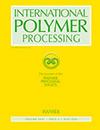模腔厚度对聚丙烯/碳微模电学、形态和热学性能的影响
IF 1.9
4区 工程技术
Q4 ENGINEERING, CHEMICAL
引用次数: 0
摘要
摘要在本工作中,对不同零件厚度(即0.85和0.50mm)的聚丙烯(PP)/碳微粒的电导率(σ)和热性能进行了比较研究。采用两种不同类型的碳填料(即CNT和CB)来研究不同碳填料对PP/碳微粒σ的改善效果。通常,无论碳填料类型和测试方向如何,0.85 mm厚度的微米部分的σ都高于0.50 mm厚度的纳米部分。这表明,微注射成型(μIM)工艺中普遍存在的较高剪切条件不利于在相应的成型品中形成完整的导电通路,尽管碳填料的分布随着剪切速率的增加而变得更好,正如形态学观察所证实的那样。差示扫描量热法结果表明,聚合物熔体经历的先前热机械历史(包括熔体共混和μIM)对随后成型的热行为有影响。此外,在μIM过程中,由于微部分的结晶度高于原料,聚合物链存在强烈的剪切流诱导结晶。本文章由计算机程序翻译,如有差异,请以英文原文为准。
Influence of mold cavity thickness on electrical, morphological and thermal properties of polypropylene/carbon micromoldings
Abstract In this work, a comparative study on the electrical conductivity (σ) and thermal properties of polypropylene (PP)/carbon microparts with different part thickness (namely, 0.85 and 0.50 mm) is reported. Two different types of carbon filler (i.e., CNT and CB) were adopted to study the efficacy of different carbon fillers in improving the σ of PP/carbon microparts. In general, the σ of 0.85 mm thickness microparts were higher than the 0.50 mm thickness microparts, regardless of the carbon filler type and testing directions. This suggested that higher shearing conditions that prevailed in the microinjection molding (μIM) process were unfavorable for the formation of intact conductive pathways in corresponding moldings, albeit the distribution of carbon fillers turned better with increasing shear rates, as confirmed by morphology observations. Differential scanning calorimetry results showed that prior thermomechanical histories (including melt blending and μIM) experienced by the polymer melts had an influence on the thermal behavior of subsequent moldings. Also, there existed a strong shear flow-induced crystallization of polymer chains during μIM because the crystallinity of microparts was higher than that of feed materials.
求助全文
通过发布文献求助,成功后即可免费获取论文全文。
去求助
来源期刊

International Polymer Processing
工程技术-高分子科学
CiteScore
2.20
自引率
7.70%
发文量
62
审稿时长
6 months
期刊介绍:
International Polymer Processing offers original research contributions, invited review papers and recent technological developments in processing thermoplastics, thermosets, elastomers and fibers as well as polymer reaction engineering. For more than 25 years International Polymer Processing, the journal of the Polymer Processing Society, provides strictly peer-reviewed, high-quality articles and rapid communications from the leading experts around the world.
 求助内容:
求助内容: 应助结果提醒方式:
应助结果提醒方式:


